Cold Brew vs. Iced Coffee: What’s the Difference?
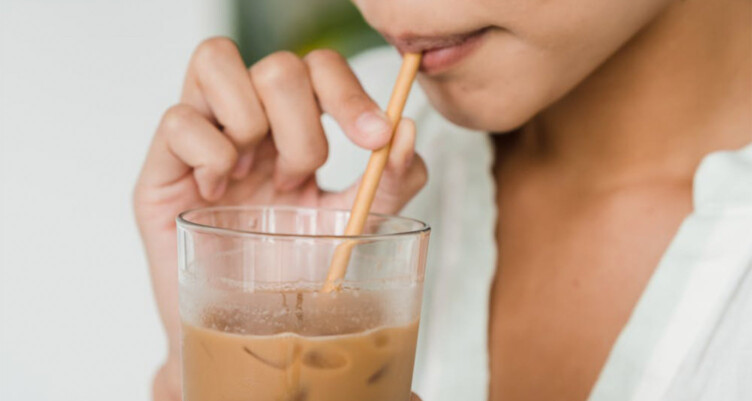
- Cold coffee drinks are becoming more popular, which is prompting consumers to choose specific methods for brewing it.
- Cold brew is a specific extraction method for making coffee, while iced coffee is any coffee served cold.
- We’ll cover the differences in how the two are made, including the steps, caffeine content, equipment and flavors.
As the weather warms up, you might be inclined to change up your coffee order. Whether you brew your own at home or treat yourself at a local coffee shop, warmer temperatures make cold brew and iced coffee sound more appealing than a cappuccino or Americano.
Coffee is the most popular drink in America, and hot coffee is still the #1 way it’s consumed.[1] But cold coffee drinks are quickly gaining in popularity. As our coffee orders shift, so is our preference for how it’s prepared. According to a 2021 paper published in the journal Foods, cold brew is replacing iced coffee – with sales up over 500% in only a five-year period.[2] But what’s the difference?
While iced coffee is any hot coffee that’s served over ice, cold brew is a specific extraction method for making coffee. In this piece, we will talk about the differences in how they are made, the process for making them, and the taste differences. And, no matter which you prefer, we’ll explain how you can enjoy them with your favorite Bulletproof Coffee.
What is Iced Coffee
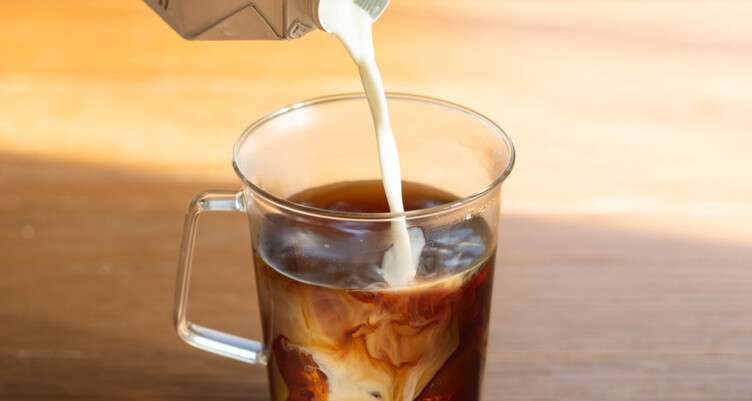
Iced coffee is coffee that’s served cold. It can start as hot coffee that’s left over and chilled, or it can be fresh-brewed hot coffee that’s immediately served over ice. Saving leftover coffee and serving it iced is an economical habit, but it might not be the best technique for coffee connoisseurs, since it can taste bitter or watered-down.
How to Make Iced Coffee
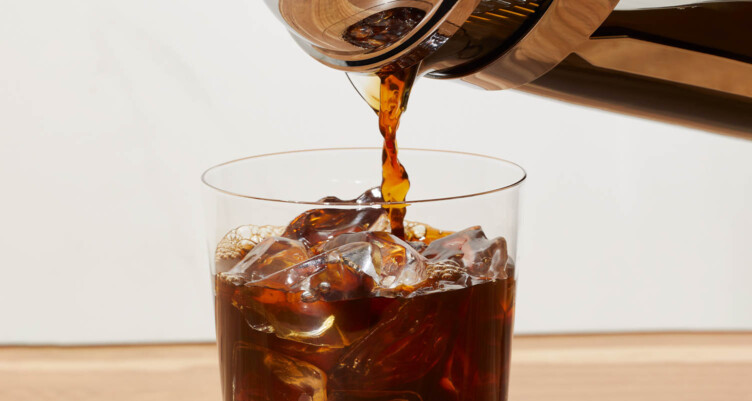
Making iced coffee is simple.
- Start by grinding your coffee beans to the appropriate size for the method you’ll use.
- Brew your coffee as desired.
- Cool down your coffee, either by refrigerating it or pouring over ice to enjoy immediately.
Curious about how to keep that perfect creamy texture when you add ice to your favorite coffee? Here’s how to make Iced Bulletproof Coffee.
What Does Iced Coffee Taste Like?
Iced coffee sometimes tastes weaker than hot coffee, since the ice will dilute your drink as it melts. To retain the rich, strong flavor of your normal coffee, consider brewing the coffee stronger than usual (with twice the grounds) or using ice cubes made of coffee.
Iced coffee requires two ingredients: coffee and water. Choose your coffee bean carefully to ensure you get a flavorful, delicious cup every time.
Caffeine in Iced Coffee
The caffeine content in your iced coffee will depend on how much you drink and how strongly it is brewed, among other factors. Different varieties and roasts of coffee beans can have more or less caffeine.[3] The US Food and Drug Administration says that healthy adults can consume up to about 400 mg of caffeine a day without harmful side effects.[4] That’s equal to about four or five (8-ounce) cups of coffee. Caffeine has an average half-life of about five hours in most individuals, but different people metabolize it faster or slower, so keep that in mind when consuming coffee or any caffeinated drink.[5]
Here’s how different coffee methods compare in terms of caffeine content[6]:
Brewed coffee: 96 mg per 8-ounce cup
Espresso: about 64 mg per 1-ounce “single” shot
Instant coffee: about 62 mg per 8-ounce cup
What is Cold Brew Coffee?
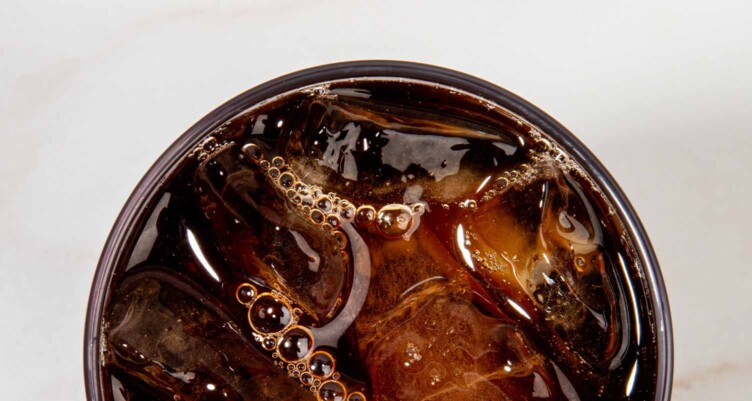
Cold Brew Coffee is a specific preparation method that uses no heat. While cold brew has been on the rise in the US since about 2010, it’s been around since the 1600s, when Dutch explorers brought coffee to Japan.[7]
The process is passive, allowing the flavor to develop and intensify using a slow extraction process and a large, coarse grind. The long extraction time results in a smooth flavor with lower acidity than coffee brewed with hot water.[8] Typically, cold brews taste less bitter and more delicate, too. The exact same coffee beans will taste different when brewed using cold vs. hot methods.
Cold brew is the third most popular way to prepare coffee, according to the National Coffee Association, after single-cup systems and drip coffee.[9] “Cold brew” refers to the brewing method – not the serving method. Before iced coffee drinks became popular, concentrated cold brew was commonly combined with boiling water and served hot. (And it still can be if you prefer!)
How Is Cold Brew Made?
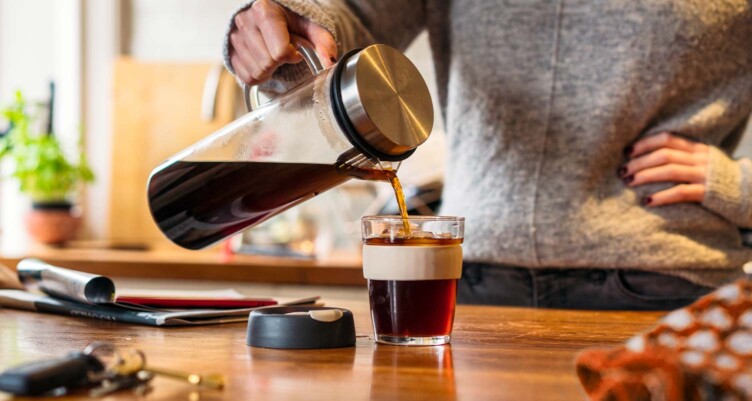
Here’s how to make cold brew coffee. You’ll need a coffee grinder, filtered cold or room-temperature water, a filter (such as a sieve lined with cheesecloth) and a pitcher, jar or French press.
- Grind your coffee beans. They should be large and coarse, about the size of rock salt. While the ratio is your choice, start with 1 cup ground coffee to 8 cups water.
- Add the grounds to your container, then add the water slowly. Stir gently, to ensure all the grounds are moistened. Cover with cheesecloth or a filter if your container doesn’t have a lid.
- Refrigerate or let sit at room temperature for 12 hours or overnight.
- Carefully strain the coffee, discard the used coffee grounds and taste your concentrate.
- Serve over ice, mix with water (hot or cold) to taste. You can also add your milk of choice.
- Store any leftovers in a container with a tight-fitting lid for up to two weeks.
What does cold brew taste like?
Iced coffee can sometimes taste flat, since the coffee was extracted using hot water. However, cold brew develops a smooth, nuanced flavor during the slow extraction. It also tastes less acidic. And, since cold brew is often made using more coffee and less water, it has a stronger flavor than iced coffee or hot coffee.
How much caffeine in cold brew?
Cold brew uses more coffee beans and less water, so that means more caffeine. The exact amount of caffeine will depend on the extraction time, roasting temperature and grind size.[10] Longer brew times and smaller grinds yield more caffeine, for example.
If you want the flavor of coffee without the effects of caffeine, you can make both cold brew or iced coffee using decaf. Choose a coffee that’s been decaffeinated using the Swiss Water® Process instead of chemicals – like Bulletproof Original Decaf.
Cold Brew vs. Iced Coffee
So how do they compare: cold brew vs iced coffee? Ultimately, it’s a personal choice, but here are some things to consider.
Prep time: Iced coffee is the winner if you’re short on time. Cold brew takes at least 12 hours to prepare.
Flavor: Cold brew’s slow, low extraction coaxes out specific flavors and nuances from your beans. If you’re adding creamers and mix-ins, regular iced coffee or cold brew is fine. If you like to taste different notes in your coffee, choose cold brew. Do keep in mind that leftover coffee sometimes doesn’t taste as fresh or smooth. Experiment with different beans to see which notes you can discern, such as the rich, nutty flavors of The Mentalist or smoky, smooth notes of French Kick.
Ease: Iced coffee wins for immediate ease, since you can brew and drink it immediately. But cold brew earns points because, while it takes time to prepare, it yields a large batch that will be ready when you want to enjoy it. Cold brew keeps for up to two weeks.
Caffeine content: This will vary based on the beans you choose and the amount you consume. However, iced coffee is usually more diluted, so it will have less caffeine.
Storage time: Iced coffee should be consumed within 24 hours, but preferably less. However, cold brew can be kept for up to two weeks.
Equipment: Iced coffee uses the same equipment that hot coffee does. You can use your drip coffee machine, a French press or even a pour-over set-up. Cold brew requires a container and a filter, as well as a coffee grinder. If you don’t have access to one, opt for iced coffee over cold brew and choose a quality ground coffee.
If you start with high-quality, clean coffee beans, you can make delicious iced coffee or cold brew. Try them both and see which you like better!
Sign up for early access to sales, product launches, the latest Bulletproof news and more!



